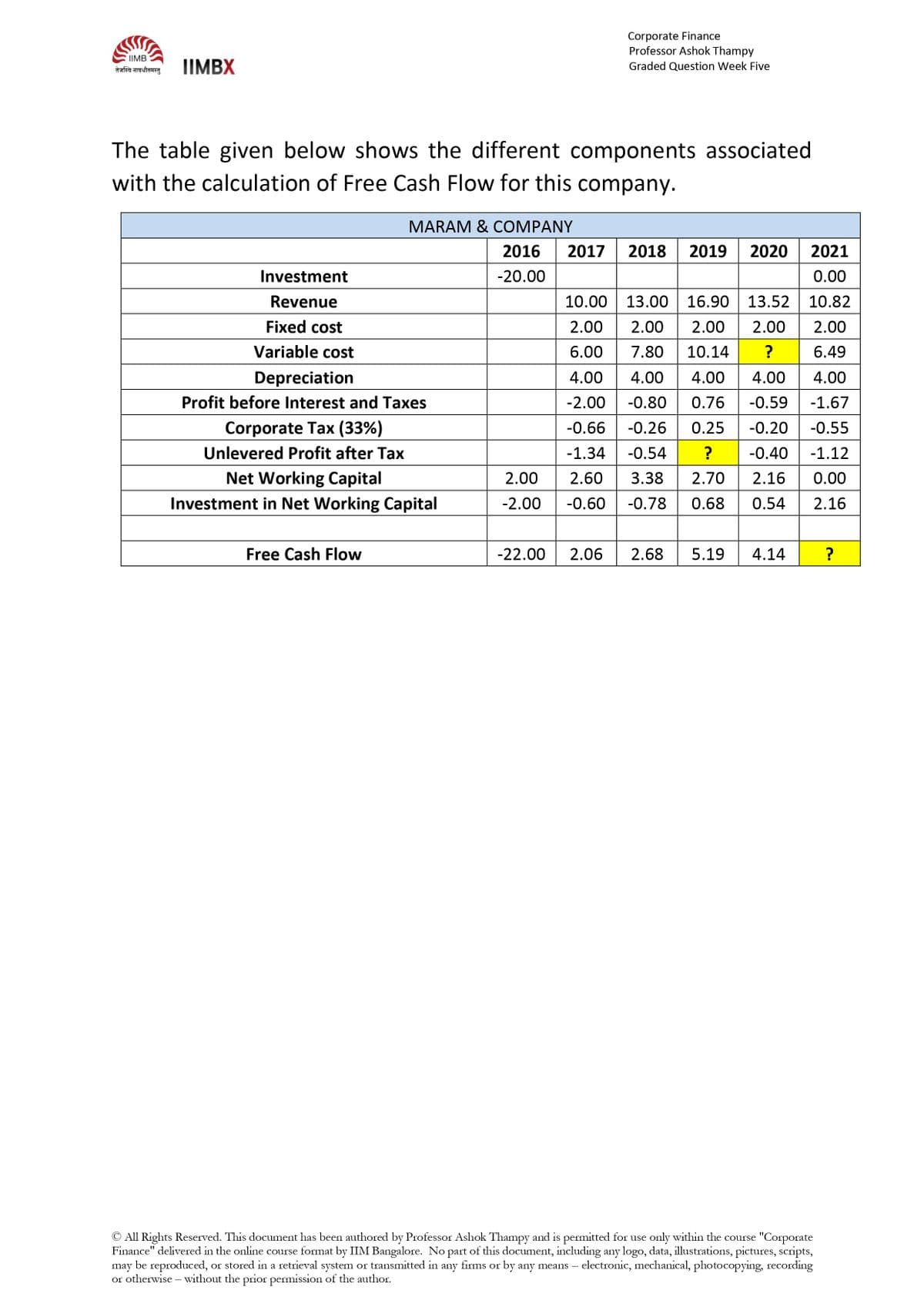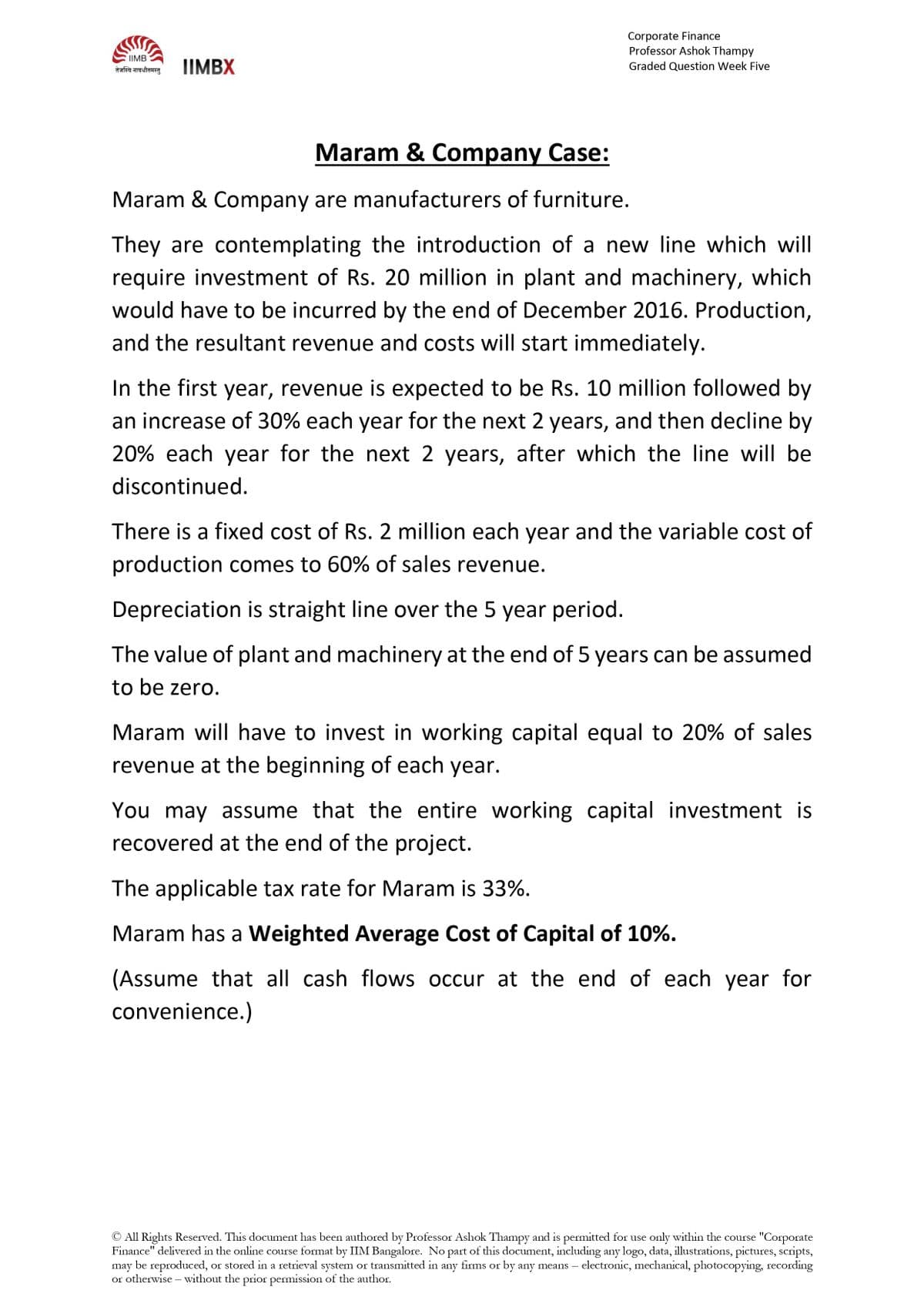Maram & Company are manufacturers of furniture. They are contemplating the introduction of a new line which will require investment of Rs. 20 million in plant and machinery, which would have to be incurred by the end of December 2016. Production, and the resultant revenue and costs will start immediately. In the first year, revenue is expected to be Rs. 10 million followed by an increase of 30% each year for the next 2 years, and then decline by 20% each year for the next 2 years, after which the line will be discontinued. There is a fixed cost of Rs. 2 million each year and the variable cost of
Maram & Company are manufacturers of furniture. They are contemplating the introduction of a new line which will require investment of Rs. 20 million in plant and machinery, which would have to be incurred by the end of December 2016. Production, and the resultant revenue and costs will start immediately. In the first year, revenue is expected to be Rs. 10 million followed by an increase of 30% each year for the next 2 years, and then decline by 20% each year for the next 2 years, after which the line will be discontinued. There is a fixed cost of Rs. 2 million each year and the variable cost of
Financial Management: Theory & Practice
16th Edition
ISBN:9781337909730
Author:Brigham
Publisher:Brigham
Chapter2: Financial Statements, Cash Flow,and Taxes
Section: Chapter Questions
Problem 21SP: Begin with the partial model in the file Ch02 P21 Build a Model.xlsx on the textbooks Web site. a....
Related questions
Question
Maram and Company should proceed with the project.
True
False

Transcribed Image Text:Corporate Finance
Professor Ashok Thampy
IIMB
IIMBX
Graded Question Week Five
तेजस्वि नावधीतमस्तु
The table given below shows the different components associated
with the calculation of Free Cash Flow for this company.
MARAM & COMPANY
2016
2017
2018 2019 | 2020 2021
Investment
-20.00
0.00
Revenue
10.00
13.00 | 16.90 13.52
10.82
2.00| 2.00 2.00 2.00
7.80 10.14
4.00 4.00 4.00
-2.00 -0.80 0.76
Fixed cost
2.00
Variable cost
6.00
?
6.49
Depreciation
4.00 4.00
Profit before Interest and Taxes
-0.59 -1.67
Corporate Tax (33%)
-0.66 -0.26 0.25
-0.20 -0.55
Unlevered Profit after Tax
-1.34
-0.54
?
-0.40
-1.12
2.60 3.38 2.70
-0.78 0.68 0.54
Net Working Capital
2.00
2.16 0.00
Investment in Net Working Capital
-2.00
-0.60
2.16
Free Cash Flow
-22.00
2.06
2.68
5.19
4.14
All Rights Reserved. This document has been authored by Professor Ashok Thampy and is permitted for use only within the course "Corporate
Finance" delivered in the online course format by IIM Bangalore. No part of this document, including any logo, data, illustrations, pictures, scripts,
may be reproduced, or stored in a retrieval system or transmitted in any firms or by any means – electronic, mechanical, photocopying, recording
or otherwise – without the prior permission of the author.

Transcribed Image Text:Corporate Finance
Professor Ashok Thampy
IIMB
तेजस्वि नावधीतमस्तु
IIMBX
Graded Question Week Five
Maram & Company Case:
Maram & Company are manufacturers of furniture.
They are contemplating the introduction of a new line which will
require investment of Rs. 20 million in plant and machinery, which
would have to be incurred by the end of December 2016. Production,
and the resultant revenue and costs will start immediately.
In the first year, revenue is expected to be Rs. 10 million followed by
an increase of 30% each year for the next 2 years, and then decline by
20% each year for the next 2 years, after which the line will be
discontinued.
There is a fixed cost of Rs. 2 million each year and the variable cost of
production comes to 60% of sales revenue.
Depreciation is straight line over the 5 year period.
The value of plant and machinery at the end of 5 years can be assumed
to be zero.
Maram will have to invest in working capital equal to 20% of sales
revenue at the beginning of each year.
You may assume that the entire working capital investment is
recovered at the end of the project.
The applicable tax rate for Maram is 33%.
Maram has a Weighted Average Cost of Capital of 10%.
(Assume that all cash flows occur at the end of each year for
convenience.)
All Rights Reserved. This document has been authored by Professor Ashok Thampy and is permitted for use only within the course "Corporate
Finance" delivered in the online course format by IIM Bangalore. No part of this document, including any logo, data, illustrations, pictures, scripts,
may be reproduced, or stored in a retrieval system or transmitted in any firms or by any means – electronic, mechanical, photocopying, recording
or otherwise – without the prior permission of the author.
Expert Solution
This question has been solved!
Explore an expertly crafted, step-by-step solution for a thorough understanding of key concepts.
This is a popular solution!
Trending now
This is a popular solution!
Step by step
Solved in 2 steps with 2 images

Knowledge Booster
Learn more about
Need a deep-dive on the concept behind this application? Look no further. Learn more about this topic, finance and related others by exploring similar questions and additional content below.Recommended textbooks for you







Managerial Accounting
Accounting
ISBN:
9781337912020
Author:
Carl Warren, Ph.d. Cma William B. Tayler
Publisher:
South-Western College Pub


Intermediate Financial Management (MindTap Course…
Finance
ISBN:
9781337395083
Author:
Eugene F. Brigham, Phillip R. Daves
Publisher:
Cengage Learning